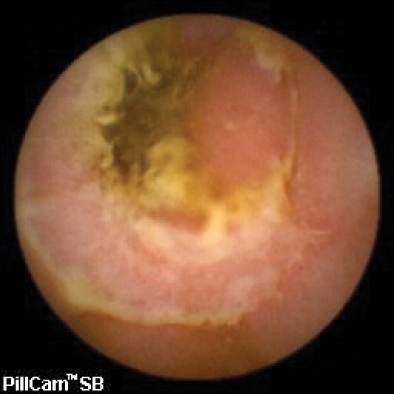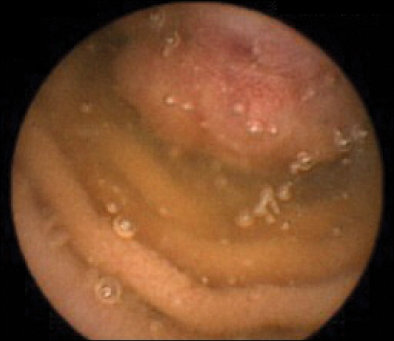Korean J Pediatr Gastroenterol Nutr.
2010 Mar;13(1):1-6. 10.5223/kjpgn.2010.13.1.1.
Capsule Endoscopy in Children
- Affiliations
-
- 1Department of Pediatrics, Seoul National University College of Medicine, Seoul, Korea. kojs@snu.ac.kr
- KMID: 1459438
- DOI: http://doi.org/10.5223/kjpgn.2010.13.1.1
Abstract
- The small bowel is the most difficult intestinal segment to examine. Radiologic tests are mostly insensitive and double-balloon enteroscopy is unsuitable for the younger child. Capsule endoscopy is a novel wireless method of investigation of the small bowel. The primary indications for capsule endoscopy include evaluation of obscure gastrointestinal bleeding, small bowel Crohn's disease, and polyposis syndromes. Capsule endoscopy offers an accurate and effective means of investigating the small bowel in children. Capsule retention is a potential complication of capsule endoscopy. This review provides the indications, safety, and limitations of wireless capsule endoscopy in children.
Keyword
MeSH Terms
Figure
Cited by 1 articles
-
The Role of Capsule Endoscopy in the Diagnosis of Crohn's Disease
Kang Won Rhee
Pediatr Gastroenterol Hepatol Nutr. 2012;15(1):8-12. doi: 10.5223/pghn.2012.15.1.8.
Reference
-
1. Fritscher-Ravens A, Scherbakov P, Bufler P, Torroni F, Ruuska T, Nuutinen H, et al. The feasibility of wireless capsule endoscopy in detecting small intestinal pathology in children under the age of 8 years: a multicentre European study. Gut. 2009. 58:1467–1472.
Article2. Park HJ, Lee SY, Ko JS, Seo JK. Usefulness of capsule endoscopy in children with suspected small bowel disease. Korean J Gastrointest Endosc. 2009. 39:346–351.3. Lim YJ, Moon JS, Chang DK, Jang BI, Chun HJ, et al. Gut Image Study Group. Korean Society of Gastrointestinal Endoscopy (KSGE) guidelines for credentialing and granting previleges for capsule endoscopy. Korean J Gastrointest Endosc. 2008. 37:393–402.4. de'Angelis GL, Fornaroli F, de'Angelis N, Magiteri B, Bizzarri B. Wireless capsule endoscopy for pediatric small-bowel diseases. Am J Gastroenterol. 2007. 102:1749–1757.5. Triester SL, Leighton JA, Leontiadis GI, Fleischer DE, Hara AK, Heigh RI, et al. A meta-analysis of the yield of capsule endoscopy compared to other diagnostic modalities in patients with obscure gastrointestinal bleeding. Am J Gastroenterol. 2005. 100:2407–2418.
Article6. Pennazio M, Santucci R, Rondonotti E, Abbiati C, Beccari G, Rossini FP, et al. Outcome of patients with obscure gastrointestinal bleeding after capsule endoscopy: report of 100 consecutive cases. Gastroenterology. 2004. 126:643–653.
Article7. Guilhon de Araujo Sant'Anna AM, Dubois J, Miron MC, Seidman EG. Wireless capsule endoscopy for obscure small-bowel disorders: final results of the first pediatric controlled trial. Clin Gastroenterol Hepatol. 2005. 3:264–270.
Article8. Preud'Homme DL, Michail S, Hodges C, Milliken T, Mezoff AG. Use of wireless capsule endoscopy in the management of severe Henoch-Schonlein purpura. Pediatrics. 2006. 118:e904–e906.9. Kang KS, Oh HJ, Ko JS, Seo JK, Park KW, Kang KH. A case of blue rubber bleb nevus syndrome. Korean J Pediatr Gastroenterol Nutr. 2008. 11:198–203.
Article10. Alexander JA, Leighton JA. Capsule endoscopy and balloon-assisted endoscopy: competing or complementary technologies in the evaluation of small bowel disease? Curr Opin Gastroenterol. 2009. 25:433–437.
Article11. Marmo R, Rotondano G, Piscopo R, Bianco MA, Siani A, Catalano O, et al. Capsule endoscopy versus enteroclysis in the detection of small-bowel involvement in Crohn's disease: a prospective trial. Clin Gastroenterol Hepatol. 2005. 3:772–776.
Article12. Arguelles-Arias F, Caunedo A, Romero J, Sanchez A, Rodriguez-Tellez M, Pellicer FJ, et al. The value of capsule endoscopy in pediatric patients with a suspicion of Crohn's disease. Endoscopy. 2004. 36:869–873.
Article13. Moy L, Levine J. Wireless capsule endoscopy in the pediatric age group: experience and complications. J Pediatr Gastroenterol Nutr. 2007. 44:516–520.
Article14. Cohen SA, Gralnek IM, Ephrath H, Saripkin L, Meyers W, Sherrod O, et al. Capsule endoscopy may reclassify pediatric inflammatory bowel disease: a historical analysis. J Pediatr Gastroenterol Nutr. 2008. 47:31–36.
Article15. Moy L, Levine J. Capsule endoscopy in the evaluation of patients with unexplained growth failure. J Pediatr Gastroenterol Nutr. 2009. 48:647–650.
Article16. Bousvaros A, Antonioli DA, Colletti RB, Dubinsky MC, Glickman JN, Gold BD, et al. Differentiating ulcerative colitis from Crohn disease in children and young adults: report of a working group of the North American Society for Pediatric Gastroenterology, Hepatology, and Nutrition and the Crohn's and Colitis Foundation of America. J Pediatr Gastroenterol Nutr. 2007. 44:653–674.
Article17. Seidman EG, Dirks MH. Capsule endoscopy in the pediatric patient. Curr Treat Options Gastroenterol. 2006. 9:416–422.
Article18. Burke CA, Santisi J, Church J, Levinthal G. The utility of capsule endoscopy small bowel surveillance in patients with polyposis. Am J Gastroenterol. 2005. 100:1498–1502.
Article19. Postgate A, Hyer W, Phillips R, Gupta A, Burling D, Bartram C, et al. Feasibility of video capsule endoscopy in the management of children with Peutz-Jeghers syndrome: a blinded comparison with barium enterography for the detection of small bowel polyps. J Pediatr Gastroenterol Nutr. 2009. 49:417–423.
Article20. Wu JF, Liou JH, Lien HC, Hsu WM, Fang YJ, Chang MH, et al. Bleeding from ileal nodular lymphoid polyposis identified by capsule endoscopy. J Pediatr Gastroenterol Nutr. 2004. 39:295–298.
Article21. Iaquinto G, Fornasarig M, Quaia M, Giardullo N, D'Onofrio V, Iaquinto S, et al. Capsule endoscopy is useful and safe for small-bowel surveillance in familial adenomatous polyposis. Gastrointestinal Endoscopy. 2008. 67:61–67.
Article22. Thomson M, Fritscher-Ravens A, Mylonaki M, Swain P, Eltumi M, Heuschkel R, et al. Wireless capsule endoscopy in children: a study to assess diagnostic yield in small bowel disease in paediatric patients. J Pediatr Gastroenterol Nutr. 2007. 44:192–197.
Article23. El-Matary W. Wireless capsule endoscopy: indications, limitations, and future challenges. J Pediatr Gastroenterol Nutr. 2008. 46:4–12.
Article24. Culliford A, Daly J, Diamond B, Rubin M, Green PH. The value of wireless capsule endoscopy in patients with complicated celiac disease. Gastrointest Endosc. 2005. 62:55–61.
Article25. Atay O, Mahajan L, Kay M, Mohr F, Kaplan B, Wyllie R. Risk of capsule endoscope retention in pediatric patients: a large single-center experience and review of the literature. J Pediatr Gastroenterol Nutr. 2009. 49:196–201.
Article26. Boivin ML, Lochs H, Voderholzer WA. Does passage of a patency capsule indicate small-bowel patency? A prospective clinical trial? Endoscopy. 2005. 37:808–815.
Article27. Rondonotti E, Herrerias JM, Pennazio M, Caunedo A, Mascarenhas-Saraiva M, de Franchis R. Complications, limitations, and failures of capsule endoscopy: a review of 733 cases. Gastrointest Endosc. 2005. 62:712–716.
Article28. Leighton JA, Sharma VK, Srivathsan K, Heigh RI, McWane TL, Fleischer DE, et al. Safety of capsule endoscopy in patients with pacemakers. Gastrointest Endosc. 2004. 59:567–569.
Article29. Waterman M, Gralnek IM. Capsule endoscopy of the esophagus. J Clin Gastroenterol. 2009. 43:605–612.
Article30. Van Gossum A, Munoz-Navas M, Fernandez-Urien I, Carretero C, Gay G, Delvaux M, et al. Capsule endoscopy versus colonoscopy for the detection of polyps and cancer. N Engl J Med. 2009. 361:264–270.
Article31. Ciuti G, Donlin R, Valdastri P, Arezzo A, Menciassi A, Morino M, et al. Robotic versus manual control in magnetic steering of an endoscopic capsule. Endoscopy. 2010. 42:148–152.
Article
- Full Text Links
- Actions
-
Cited
- CITED
-
- Close
- Share
- Similar articles
-
- The Role of Capsule Endoscopy in the Diagnosis of Crohn's Disease
- Colon Capsule Endoscopy for Inflammatory Bowel Disease
- Current and Future Use of Esophageal Capsule Endoscopy
- The Future of Capsule Endoscopy: The Role of Artificial Intelligence and Other Technical Advancements
- Small Bowel Obstruction and Capsule Retention by a Small Bowel Ulcer That Was Not Found on Capsule Endoscopy



